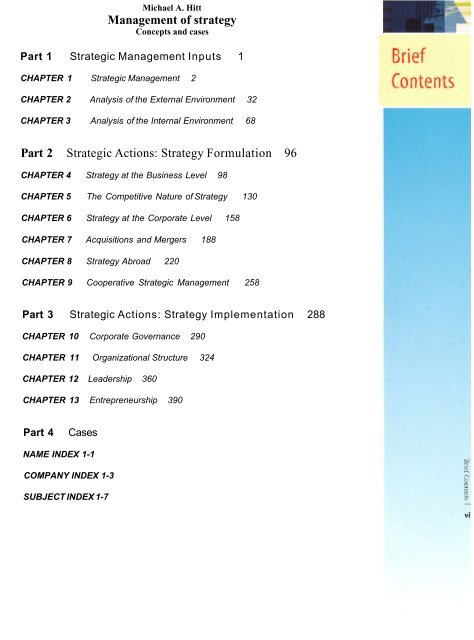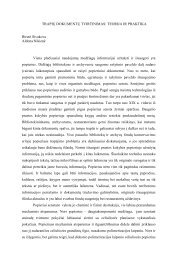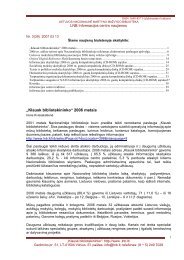Part 2 Strategic Actions: Strategy Formulation 96 Management of ...
Part 2 Strategic Actions: Strategy Formulation 96 Management of ...
Part 2 Strategic Actions: Strategy Formulation 96 Management of ...
Create successful ePaper yourself
Turn your PDF publications into a flip-book with our unique Google optimized e-Paper software.
<strong>Part</strong> 1 <strong>Strategic</strong> <strong>Management</strong> Inputs 1<br />
CHAPTER 1 <strong>Strategic</strong> <strong>Management</strong> 2<br />
CHAPTER 2 Analysis <strong>of</strong> the External Environment 32<br />
CHAPTER 3 Analysis <strong>of</strong> the Internal Environment 68<br />
<strong>Part</strong> 2 <strong>Strategic</strong> <strong>Actions</strong>: <strong>Strategy</strong> <strong>Formulation</strong> <strong>96</strong><br />
CHAPTER 4 <strong>Strategy</strong> at the Business Level 98<br />
CHAPTER 5 The Competitive Nature <strong>of</strong> <strong>Strategy</strong> 130<br />
CHAPTER 6 <strong>Strategy</strong> at the Corporate Level 158<br />
CHAPTER 7 Acquisitions and Mergers 188<br />
CHAPTER 8 <strong>Strategy</strong> Abroad 220<br />
CHAPTER 9 Cooperative <strong>Strategic</strong> <strong>Management</strong> 258<br />
<strong>Part</strong> 3 <strong>Strategic</strong> <strong>Actions</strong>: <strong>Strategy</strong> Implementation 288<br />
CHAPTER 10 Corporate Governance 290<br />
CHAPTER 11 Organizational Structure 324<br />
CHAPTER 12 Leadership 360<br />
CHAPTER 13 Entrepreneurship 390<br />
<strong>Part</strong> 4 Cases<br />
NAME INDEX 1-1<br />
COMPANY INDEX 1-3<br />
SUBJECT INDEX 1-7<br />
Michael A. Hitt<br />
<strong>Management</strong> <strong>of</strong> strategy<br />
Concepts and cases
Preface xxv<br />
<strong>Part</strong> 1 <strong>Strategic</strong> <strong>Management</strong> Inputs 1<br />
CHAPTER 1 <strong>Strategic</strong> <strong>Management</strong> 2<br />
Opening Case: General Motors: How Bright Is the Future? 3<br />
The 21 st-Century Competitive Landscape 6<br />
The Global Economy 7<br />
The March <strong>of</strong> Globalization 8<br />
Technology and Technological Changes 10<br />
<strong>Strategic</strong> Focus: Amazon.com: Using Technology to Create<br />
Change 12<br />
<strong>Strategic</strong> Focus: Organizational Change: Be Ready, Because It<br />
Can't Be Avoided! 14<br />
The I/O Model <strong>of</strong> Above-Average Returns 15<br />
The Resource-Based Model <strong>of</strong> Above-Average Returns 17<br />
Vision and Mission 19<br />
Vision 19<br />
Mission 20<br />
Stakeholders 21<br />
Classifications <strong>of</strong> Stakeholders 21<br />
<strong>Strategic</strong> Leaders 24<br />
The Work <strong>of</strong> Effective <strong>Strategic</strong> Leaders 25<br />
Predicting Outcomes <strong>of</strong> <strong>Strategic</strong> Decisions: Pr<strong>of</strong>it Pools 25<br />
The <strong>Strategic</strong> <strong>Management</strong> Process 26<br />
Summary 28<br />
Notes 29
CHAPTER 2 Analysis <strong>of</strong> the External Environment 32<br />
Opening Case: General and Competitive Environmental<br />
Influences on U.S.Airlines 33<br />
The General, Industry, and Competitor Environments 35<br />
External Environmental Analysis 37<br />
Scanning 38<br />
Monitoring 39<br />
Forecasting 39<br />
Assessing 39<br />
Segments <strong>of</strong> the General Environment 40<br />
The Demographic Segment 40<br />
The Economic Segment 43<br />
The Political/Legal Segment 44<br />
The Sociocultural Segment 45<br />
The Technological Segment 46<br />
The Global Segment 47<br />
Industry Environment Analysis 49<br />
<strong>Strategic</strong> Focus: The Nature <strong>of</strong> the Competitive Forces in the<br />
Global Automobile Industry 50<br />
Threat <strong>of</strong> New Entrants 51<br />
Bargaining Power <strong>of</strong> Suppliers 54<br />
Bargaining Power <strong>of</strong> Buyers 55<br />
Threat <strong>of</strong> Substitute Products 55<br />
Intensity <strong>of</strong> Rivalry among Competitors 56<br />
<strong>Strategic</strong> Focus: Satellite TV Service Substitutes for Digital Cable<br />
Service, Which Substitutes for Local Telephone Service 57<br />
Interpreting Industry Analyses 59<br />
<strong>Strategic</strong> Groups 60<br />
Competitor Analysis 61<br />
Ethical Considerations 63<br />
Summary 64<br />
Notes 64
CHAPTER 3 Analysis <strong>of</strong> the Internal Environment 68<br />
Opening Case: The Capability to Innovate: A Critical Source <strong>of</strong> Competitive<br />
Advantage 69<br />
The Nature <strong>of</strong> Internal Environmental Analysis 71<br />
The Context <strong>of</strong> Internal Analysis 71<br />
Creating Value 71<br />
The Challenge <strong>of</strong> Internal Analysis 73<br />
Resources, Capabilities, and Core Competencies 75<br />
Resources 75<br />
<strong>Strategic</strong> Focus: Human Capital: Underutilizing Valuable Intangible Assets 78<br />
Capabilities 79<br />
Core Competencies 80<br />
Building Core Competencies 81<br />
Four Criteria <strong>of</strong> Sustainable Competitive Advantage 81<br />
Value Chain Analysis 85<br />
Outsourcing 88<br />
<strong>Strategic</strong> Focus: Outsourcing—Boon or Bane to Competitiveness? 90<br />
Competencies, Strengths,Weaknesses,and <strong>Strategic</strong> Decisions 91<br />
Summary 92<br />
Notes 93<br />
<strong>Part</strong> 2 <strong>Strategic</strong> <strong>Actions</strong>: <strong>Strategy</strong><br />
<strong>Formulation</strong> <strong>96</strong><br />
CHAPTER 4 <strong>Strategy</strong> at the Business Level 98<br />
Opening Case: Lamps <strong>of</strong> Distinction: Where Did the Customers Go? 99<br />
Customers:Their Relationship with Business-Level Strategies 101<br />
Effectively Managing Relationships with Customers 102<br />
Reach, Richness, and Affiliation 102<br />
Who: Determining the Customers to Serve 103
What: Determining Which Customer Needs to Satisfy 105<br />
How: Determining Core Competencies Necessary to Satisfy Customer Needs 106<br />
The Purpose <strong>of</strong> a Business-Level <strong>Strategy</strong> 106<br />
Types <strong>of</strong> Business-Level Strategies 108<br />
Cost Leadership <strong>Strategy</strong> 109<br />
<strong>Strategic</strong> Focus: Beating Wal-Mart: It's Tough, But It Can Be Done 113<br />
Differentiation <strong>Strategy</strong> 114<br />
Focus Strategies 119<br />
Integrated Cost Leadership/Differentiation <strong>Strategy</strong> 121<br />
Summary 124<br />
Notes 126<br />
<strong>Strategic</strong> Focus: Maytag Corporation: A Cost Leader? A Differentiator? 125<br />
CHAPTER 5 The Competitive Nature <strong>of</strong> <strong>Strategy</strong> 130<br />
Opening Case: Southwest Airlines:The King <strong>of</strong> the Hill That Is Changing an<br />
Industry 131<br />
A Model <strong>of</strong> Competitive Rivalry 133<br />
Competitor Analysis 134<br />
Market Commonality 135<br />
Resource Similarity 136<br />
Drivers <strong>of</strong> Competitive <strong>Actions</strong> and Responses 137<br />
<strong>Strategic</strong> Focus: Is General Motors Stuck in the 1970s? 139<br />
Competitive Rivalry 140<br />
<strong>Strategic</strong> and Tactical <strong>Actions</strong> 140<br />
Likelihood <strong>of</strong> Attack 141<br />
First-Mover Incentives 141<br />
Organizational Size 143<br />
Quality 144<br />
Likelihood <strong>of</strong> Response 146<br />
Type <strong>of</strong> Competitive Action 146
Actor s Reputation 146<br />
Dependence on the Market 147<br />
<strong>Strategic</strong> Focus: The Continuing Saga <strong>of</strong> Coke and Pepsi Competition: Has Coke<br />
Fizzled While Pepsi Popped the Top? 148<br />
Competitive Dynamics 149<br />
Slow-Cycle Markets 149<br />
Fast-Cycle Markets 150<br />
Standard-Cycle Markets 152<br />
Summary 153<br />
Notes 155<br />
CHAPTER б <strong>Strategy</strong> at the Corporate Level 158<br />
Opening Case: Dining Concepts: What Is the Best Combination? 159<br />
Levels <strong>of</strong> Diversification 161<br />
Low Levels <strong>of</strong> Diversification 161<br />
Moderate and High Levels <strong>of</strong> Diversification 163<br />
<strong>Strategic</strong> Focus: What Is the Best Way to Manage Product Diversification<br />
at GE? 164<br />
Reasons for Diversification 165<br />
Value-Creating Diversification: Related Constrained and Related Linked<br />
Diversification 167<br />
Operational Relatedness: Sharing Activities 167<br />
Corporate Relatedness: Transferring <strong>of</strong> Core Competencies 168<br />
Market Power 169<br />
<strong>Strategic</strong> Focus: Adding Maytag's Products to Whirlpool's: An Effort to Develop<br />
Market Power 170<br />
Simultaneous Operational Relatedness and Corporate Relatedness 172<br />
Unrelated Diversification 173<br />
Efficient Internal Capital Market Allocation 173<br />
Restructuring <strong>of</strong> Assets 174<br />
Value-Neutral Diversification: Incentives and Resources 175<br />
Incentives to Diversify 175
Resources and Diversification 179<br />
Value-Reducing Diversification: Managerial Motives to Diversify 180<br />
Summary 182<br />
Notes 182<br />
CHAPTER 7 Acquisitions and Mergers 188<br />
Opening Case: Domestic and Cross-Border Acquisitions: Meeting Competitive<br />
Challenges and Acquiring Critical Resources 189<br />
The Popularity <strong>of</strong> Merger and Acquisition Strategies 191<br />
Mergers, Acquisitions, and Takeovers: What Are the Differences? 192<br />
Reasons for Acquisitions 193<br />
Increased Market Power 193<br />
Overcoming Entry Barriers 195<br />
<strong>Strategic</strong> Focus: Mittal Steel Becomes the Largest Worldwide Steel Producer<br />
through a <strong>Strategy</strong> <strong>of</strong> Cross-Border Acquisitions 1<strong>96</strong><br />
Cost <strong>of</strong> New Product Development and Increased Speed to Market 197<br />
Lower Risk Compared to Developing New Products 198<br />
Increased Diversification 199<br />
Reshaping the Firm's Competitive Scope 199<br />
Learning and Developing New Capabilities 200<br />
Problems in Achieving Acquisition Success 200<br />
Integration Difficulties 201<br />
Inadequate Evaluation <strong>of</strong> Target 202<br />
Large or Extraordinary Debt 203<br />
Inability to Achieve Synergy 203<br />
Too Much Diversification 204<br />
Managers Overly Focused on Acquisitions 205<br />
Too Large 206<br />
Effective Acquisitions 206<br />
Restructuring 208<br />
Downsizing 209
Downscoping 209<br />
<strong>Strategic</strong> Focus: Restructuring through Firm Spin-<strong>of</strong>fs Allows for Value<br />
Creation 210<br />
Leveraged Buyouts 212<br />
Restructuring Outcomes 212<br />
Summary 214<br />
Notes 214<br />
CHAPTER 8 <strong>Strategy</strong> Abroad 220<br />
Opening Case: Chinese Firms' Incentives for Foreign Acquisitions 221<br />
Identifying International Opportunities: Incentives to Use an International<br />
<strong>Strategy</strong> 224<br />
Increased Market Size 225<br />
Return on Investment 226<br />
Economies <strong>of</strong> Scale and Learning 226<br />
Location Advantages 227<br />
International Strategies 228<br />
International Business-Level <strong>Strategy</strong> 228<br />
International Corporate-Level <strong>Strategy</strong> 230<br />
•<br />
Environmental Trends 233<br />
<strong>Strategic</strong> Focus: Whirlpool's Progress toward the Transnational <strong>Strategy</strong> 234<br />
Liability <strong>of</strong> Foreignness 235<br />
Regionalization 236<br />
Choice <strong>of</strong> International Entry Mode 237<br />
Exporting 237<br />
Licensing 238<br />
<strong>Strategic</strong> Alliances 239<br />
Acquisitions 240<br />
New Wholly Owned Subsidiary 241<br />
Dynamics <strong>of</strong> Mode <strong>of</strong> Entry 242<br />
<strong>Strategic</strong> Competitiveness Outcomes 243
International Diversification and Returns 243<br />
International Diversification and Innovation 244<br />
Complexity <strong>of</strong> Managing Multinational Firms 245<br />
Risks in an International Environment 245<br />
Political Risks 245<br />
Economic Risks 246<br />
<strong>Strategic</strong> Focus: Are China and India Changing Their Approach to Intellectual<br />
Property Enforcement? 247<br />
Limits to International Expansion: <strong>Management</strong> Problems 248<br />
Summary 249<br />
Notes 250<br />
CHAPTER 9 Cooperative <strong>Strategic</strong> <strong>Management</strong> 258<br />
Opening Case: Using Alliances to Build Greater Value 259<br />
<strong>Strategic</strong> Alliances as a Primary Type <strong>of</strong> Cooperative <strong>Strategy</strong> 261<br />
Three Types <strong>of</strong> <strong>Strategic</strong> Alliances 261<br />
Reasons Firms Develop <strong>Strategic</strong> Alliances 263<br />
Business-Level Cooperative <strong>Strategy</strong> 265<br />
Complementary <strong>Strategic</strong> Alliances 266<br />
Competition Response <strong>Strategy</strong> 268<br />
Uncertainty-Reducing <strong>Strategy</strong> 268<br />
Competition-Reducing <strong>Strategy</strong> 269<br />
Assessment <strong>of</strong> Business-Level Cooperative Strategies 270<br />
Corporate-Level Cooperative <strong>Strategy</strong> 271<br />
Diversifying <strong>Strategic</strong> Alliance 272<br />
Synergistic <strong>Strategic</strong> Alliance 272<br />
Franchising 272<br />
<strong>Strategic</strong> Focus: Franchising Finger Foods the American Way 273<br />
Assessment <strong>of</strong> Corporate-Level Cooperative Strategies 274<br />
International Cooperative <strong>Strategy</strong> 275<br />
Network Cooperative <strong>Strategy</strong> 276<br />
Alliance Network Types 276
Strategie Focus: Forming an International Alliance Network for Innovation and Its<br />
Use 277<br />
Competitive Risks with Cooperative Strategies 279<br />
Managing Cooperative Strategies 281<br />
Summary 283<br />
Notes 284<br />
<strong>Part</strong> 3 <strong>Strategic</strong> <strong>Actions</strong>: <strong>Strategy</strong><br />
Implementation 288<br />
CHAPTER 10 Corporate Governance 290<br />
Opening Case: Is Managerial Incentive Compensation Too High? 291<br />
Separation <strong>of</strong> Ownership and Managerial Control 294<br />
Agency Relationships 295<br />
Product Diversification as an Example <strong>of</strong> an Agency Problem 2<strong>96</strong><br />
Agency Costs and Governance Mechanisms 298<br />
<strong>Strategic</strong> Focus: Sarbanes-Oxley Act Increases Governance Intensity 299<br />
Ownership Concentration 301<br />
The Growing Influence <strong>of</strong> Institutional Owners 301<br />
Board <strong>of</strong> Directors 302<br />
<strong>Strategic</strong> Focus: Governing the CEO 305<br />
Enhancing the Effectiveness <strong>of</strong> the Board <strong>of</strong> Directors 306<br />
Executive Compensation 307<br />
A Complicated Governance Mechanism 307<br />
The Effectiveness <strong>of</strong> Executive Compensation 308<br />
Market for Corporate Control 309<br />
Managerial Defense Tactics 311<br />
International Corporate Governance 312<br />
Corporate Governance in Germany 313<br />
Corporate Governance in Japan 314
Global Corporate Governance 315<br />
Governance Mechanisms and Ethical Behavior 315<br />
Summary 316<br />
Notes 317<br />
CHAPTER 11 Organizational Structure 324<br />
Opening Case: Sony's Struggles with Its Online Music Business: Organization<br />
and Cooperation Difficulties among Its Businesses 325<br />
Organizational Structure and Controls 326<br />
Organizational Structure 327<br />
Organizational Controls 327<br />
<strong>Strategic</strong> Focus: A Change in Structure Leads to Improved <strong>Strategy</strong><br />
Implementation at Kellogg Co. 328<br />
Relationships between <strong>Strategy</strong> and Structure 331<br />
Evolutionary Patterns <strong>of</strong> <strong>Strategy</strong> and Organizational Structure 331<br />
Simple Structure 331<br />
Functional Structure 333<br />
Multidivisional Structure 333<br />
Matches between Business-Level Strategies and the Functional Structure 334<br />
Matches between Corporate-Level Strategies and the Multidivisional Structure 337<br />
Matches between International Strategies and Worldwide Structures 344<br />
<strong>Strategic</strong> Focus: Unilever is Reorganizing to Implement the Transnational <strong>Strategy</strong><br />
by Using the Combination Structure 349<br />
Matches between Cooperative Strategies and Network Structures 350<br />
Implementing Business-Level Cooperative Strategies 352<br />
Implementing Corporate-Level Cooperative Strategies 352<br />
Implementing International Cooperative Strategies 353<br />
Summary 354<br />
Notes 355
CHAPTER 12 Leadership 360<br />
Opening Case: Long-Term Vision or Operational Performance?The"Un-Carly"<br />
Takes Hewlett-Packard's Reins 361<br />
<strong>Strategic</strong> Leadership and Style 363<br />
The Role <strong>of</strong> Top-Level Managers 365<br />
Top <strong>Management</strong> Teams 365<br />
Managerial Succession 369<br />
Key <strong>Strategic</strong> Leadership <strong>Actions</strong> 372<br />
Determining <strong>Strategic</strong> Direction 372<br />
Effectively Managing the Firm's Resource Portfolio 373<br />
<strong>Strategic</strong> Focus: How Do Managers Acquire, Protect, and Use Resources<br />
Wisely? 374<br />
Sustaining an Effective Organizational Culture 377<br />
<strong>Strategic</strong> Focus: Change Lost in a 'Sea' <strong>of</strong> Organizational Politics 379<br />
Emphasizing Ethical Practices 380<br />
Establishing Balanced Organizational Controls 382<br />
Summary 385<br />
Notes 386<br />
CHAPTER 13 Entrepreneurship 390<br />
Opening Case: W. L.Gore & Associates:The Most Innovative Company in<br />
America? 391<br />
Entrepreneurship and Entrepreneurial Opportunities 393<br />
Innovation 394<br />
Entrepreneurs 395<br />
International Entrepreneurship 3<strong>96</strong><br />
Internal Innovation 397<br />
<strong>Strategic</strong> Focus: Panera Bread Company: Thriving through Internal<br />
Innovation 398<br />
Incremental and Radical Innovation 399
Autonomous <strong>Strategic</strong> Behavior 400<br />
Induced <strong>Strategic</strong> Behavior 402<br />
Implementing Internal Innovations 402<br />
Cross-Functional Product Development Teams 403<br />
Facilitating Integration and Innovation 403<br />
Creating Value from Internal Innovation 404<br />
Innovation through Cooperative Strategies 405<br />
<strong>Strategic</strong> Focus: Cooperating to Innovate in the DVD Rental and Sales Markets 406<br />
Innovation through Acquisitions 407<br />
Creating Value through <strong>Strategic</strong> Entrepreneurship 408<br />
Summary 409<br />
Notes 410<br />
<strong>Part</strong> 4 Cases<br />
Preparing an Effective Case Analysis C-iii<br />
Case 1 : Tata Steel: A Century <strong>of</strong> Corporate Social Responsibilities C-1<br />
Case 2: Doing the Right Thing: Bank One's Response to the Mutual Fund<br />
Scandal C-15<br />
Case3: Louis V. Gerstner Jr.—The Man Who Turned IBM Around C-23<br />
Case 4: Lufthansa 2003: Energizing a Decade <strong>of</strong> Change C-31<br />
Case 5: General Motors Defense C-53<br />
Case 6: Mass Retailing in Asia (B) Competition C-61<br />
Case 7: ONGC's Growth <strong>Strategy</strong> C-71<br />
Case 8: 9Live: Birth <strong>of</strong> a TV Channel C-79<br />
Case 9: MapQuest C-89<br />
Case 10: Humana Inc.: Turnaround <strong>of</strong> a Health Insurer C-103<br />
Case 11: Marks and Spencer:The Downfall and Leadership Vacuum C-120<br />
Case 12: Wal-Mart Stores Inc.: Dominating Global Retailing C-128<br />
Case 13: Dell in China:The <strong>Strategic</strong> Rethinking C-142<br />
Case 14: Lucchetti C-148
Case 15: Whole Foods Market, 2005: Will There Be Enough Organic Food to<br />
Satisfy the Growing Demand? C-168<br />
Case 16: L'Oreal's Business <strong>Strategy</strong> C-178<br />
Case 17: CQUAY Technologies Corp. C-187<br />
Case 18: News Corp. in 2005: Consolidating the DirecTV Acquisition C-197<br />
Case 19: China on the l-Way C-207<br />
Case 20: Succession Battles at Viacom C-215<br />
Name Index 1-1<br />
Company Index I-3<br />
Subject Index I-7
















